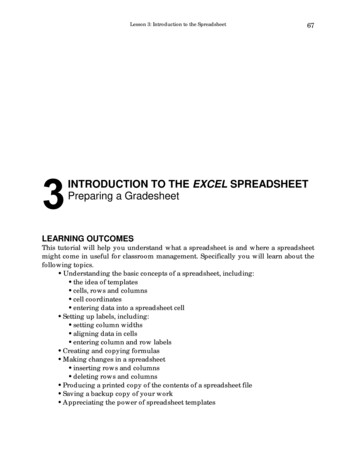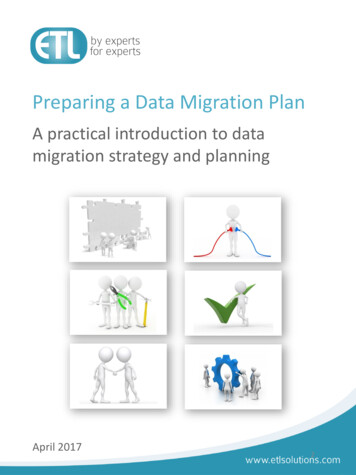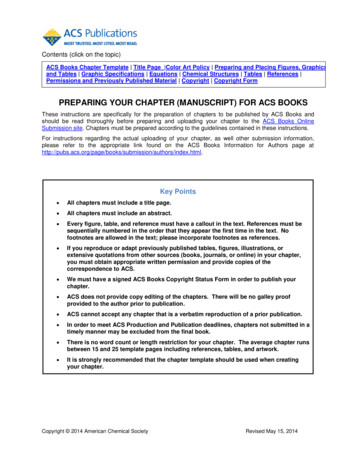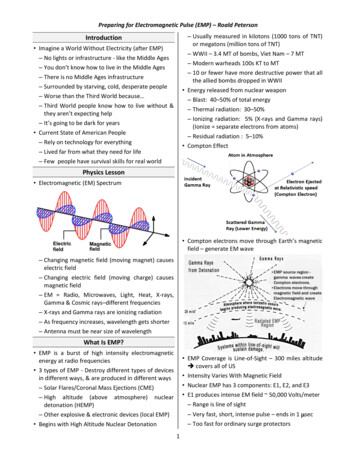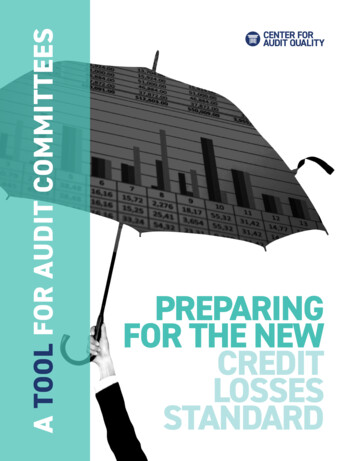
Transcription
A TOOL FOR AUDIT COMMITTEESPREPARINGFOR THE NEWCREDITLOSSESSTANDARD
ABOUT THE CENTER FOR AUDIT QUALITYThe Center for Audit Quality (CAQ) is an autonomouspublic policy organization dedicated to enhancinginvestor confidence and public trust in the global capitalmarkets. The CAQ fosters high-quality performance bypublic company auditors; convenes and collaborateswith other stakeholders to advance the discussion ofcritical issues that require action and intervention;and advocates policies and standards that promotepublic company auditors’ objectivity, effectiveness, andresponsiveness to dynamic market conditions. Based inWashington, DC, the CAQ is affiliated with the AmericanInstitute of CPAs.Please note that this publication is intended as generalinformation and should not be relied upon as beingdefinitive or all-inclusive. As with all other CAQ resources,this is not authoritative, and readers are urged to referto relevant rules and standards. If legal advice or otherexpert assistance is required, the services of a competentprofessional should be sought. The CAQ makes norepresentations, warranties, or guarantees about, andassumes no responsibility for, the content or applicationof the material contained herein. The CAQ expresslydisclaims all liability for any damages arising out of theuse of, reference to, or reliance on this material. Thispublication does not represent an official position of theCAQ, its board, or its members.PREPARINGFOR THE NEWCREDIT LOSSESSTANDARD
PREPARING FOR THE NEW CREDIT LOSSES STANDARD: A TOOL FOR AUDIT COMMITTEESINTRODUCTIONThe Financial Accounting Standards Board (FASB)has issued a new accounting standard1 that willsignificantly change how companies accountfor credit losses for most financial assets andcertain other instruments.2 One key change isthe requirement to measure certain credit lossesunder a new model, commonly referred to as thecurrent expected credit loss (CECL) model. For mostcalendar year–end public companies consideredSecurities and Exchange Commission (SEC) filers,the new standard is effective January 1, 2020.The new standard has broad implications acrossthe financial reporting ecosystem and affectscompanies holding financial assets and netinvestment in leases that are not accounted for atfair value through net income. As investors lookto understand the impact of the new standard, itis important now for audit committee members,auditors, and preparers to plan appropriately fortimely implementation.The new standard affects accounting for loans,held-to-maturity (HTM) debt securities, accounts(trade) receivables, net investments in leases,certain off-balance-sheet credit exposures,reinsurance receivables, and other financial assetsincluded in the scope.3 It also makes changes tothe impairment model for available-for-sale (AFS)securities. Implementation of the new standard isa significant effort and will affect many companies,not just banks.1 Accounting Standards Update No. 2016-13, Financial Instruments – Credit Losses (Topic 326): Measurement of Credit Losses on FinancialInstruments (ASU No. 2016-13).2 Accounting Standards Codification (ASC) 326-20-15-2.3 Ibid.CENTER FOR AUDIT QUALITY THECAQ.ORG1
PREPARING FOR THE NEW CREDIT LOSSES STANDARD: A TOOL FOR AUDIT COMMITTEES“THE STANDARD DOES NOT SPECIFY A ONE-SIZE-FITS-ALLMETHOD FOR MEASURING EXPECTED CREDIT LOSSES.RATHER, COMPANIES WILL NEED TO USE REASONABLEJUDGMENT TO DEVELOP ESTIMATION METHODS THAT AREWELL DOCUMENTED, APPLIED CONSISTENTLY OVER TIME,AND FAITHFULLY ESTIMATE THE COMPANY’S ESTIMATE OFEXPECTED CREDIT LOSSES.”Wesley Bricker, SEC Chief AccountantRemarks before the AICPA National Conference onBanks & Savings InstitutionsSeptember 21, 2016The Center for Audit Quality (CAQ) has developedthis tool to help audit committee members executetheir oversight responsibilities. The tool providesimportant questions to consider, such as thefollowing: A re the appropriate disclosures (including SAB74) being developed?4 How will accounting for credit losses change? What new processes and controls are beingdeveloped to consider accuracy of the adoptionof the standard? Public business entities (PBEs) that meet thedefinition of an SEC filer must comply withthe standard for fiscal years, and interimperiods within those fiscal years, beginningafter December 15, 2019. In other words, forcalendar year–end public companies (that meetthe definition of an SEC filer), the effective dateis January 1, 2020. This is important becausecompanies must prepare estimates of creditlosses using the CECL model at the beginningof the period for that adoption date. A calendaryear–end company that is a PBE and an SECfiler would comply with the standard in its firstquarterly report ending March 31, 2020. How will this impact regulatory matters such asregulatory capital? PBEs that do not meet the definition of an SECfiler must comply with the standard for fiscal Is the company on track for successfulimplementation? What are the significant judgments andestimates being made by management? How is the company preparing investors tounderstand the impact to the financial statements?The standard has three separate effective dates,dependent on the type of company.4 Staff Accounting Bulletin (SAB) No. 74 (codified in SAB Topic 11.M), Disclosure Of The Impact That Recently Issued Accounting Standards Will HaveOn The Financial Statements Of The Registrant When Adopted In A Future Period, (commonly referred to as “SAB 74”).2CENTER FOR AUDIT QUALITY THECAQ.ORG
PREPARING FOR THE NEW CREDIT LOSSES STANDARD: A TOOL FOR AUDIT COMMITTEESyears, and interim periods within those fiscalyears, beginning after December 15, 2020.In other words, for these companies with acalendar year end, the effective date is January1, 2021. All other companies5 must comply with thestandard for fiscal years beginning afterDecember 15, 2021, and for interim periodswithin those fiscal years.6 In other words, forthese companies with a calendar year end, theeffective date is January 1, 2022. Early application is permitted for all companiesfor fiscal years beginning after December 15,2018, including interim periods within thosefiscal years.7This publication has been organized into foursections and, while not all-inclusive, providesexamples of questions audit committees mayask of management and auditors related to thecompany’s implementation efforts.Understanding the Standard provides a briefoverview of the standard’s core principles.Evaluating the Company’s Impact Assessmentsuggests questions that audit committees mayconsider when discussing with managementand auditors the impact the new standard willhave on the company.WHY DID THE FASB ISSUE THISACCOUNTING STANDARDS UPDATE?Current generally accepted accountingprinciples (GAAP) requires an incurredloss methodology for recognizing certaincredit losses that delays recognition until itis probable that a loss has been incurred.Both financial institutions and users of theirfinancial statements expressed concern thatcurrent GAAP restricts the ability to recordcredit losses that are expected but that donot yet meet the probable threshold.The global financial crisis underscoredthose concerns because users analyzedcredit losses by utilizing forward-lookinginformation to assess an entity’s allowancefor credit losses on the basis of their ownexpectations. Consequently, in the lead-upto the financial crisis, users were makingestimates of expected credit losses anddevaluing financial institutions beforeaccounting losses were recognized,highlighting how the information needsof users differed from what was requiredby GAAP. Similarly, financial institutionsexpressed frustration during this periodbecause they could not record credit lossesthat they were expecting but that had not yetmet the probable threshold.8 Evaluating the Implementation Plan assistsaudit committees in their efforts to understandand evaluate management’s implementationplan.Other Important ImplementationConsiderations provides audit committeeswith other considerations, such as transitionmethods and new disclosure requirements. 5 An emerging growth company (EGC) is an issuer with less than 1.07 billion in total annual gross revenues during its most recently completed fiscalyear. If an issuer qualifies as an EGC on the first day of its fiscal year, it maintains that status until the earliest of (1) the last day of the fiscal year ofthe issuer during which it has total annual gross revenues of 1.07 billion or more; (2) the last day of its fiscal year following the fifth anniversary ofthe first sale of its common equity securities pursuant to an effective registration statement; (3) the date on which the issuer has, during the previousthree-year period, issued more than 1.07 billion in nonconvertible debt; or (4) the date on which the issuer is deemed to be a “large acceleratedfiler” (as defined in Exchange Act Rule 12b-2). See Rule 405 of Regulation C under the Securities Act and Rule 12b-2 of the Exchange Act.6 ASC 326-10-65-1.7 This is the earliest application date but not the only early application date. See ASC 326-10-65-18 ASU No. 2016-13, Summary (page 1).CENTER FOR AUDIT QUALITY THECAQ.ORG3
PREPARING FOR THE NEW CREDIT LOSSES STANDARD: A TOOL FOR AUDIT COMMITTEESI. UNDERSTANDING THESTANDARDThe new standard introduces two new subtopics,9applies to all companies, and applies to mostfinancial assets that are not measured at fair valuethrough net income (such as loans, debt securities,and accounts [trade] receivables).The CECL model must be applied at the initialrecording of the financial asset while consideringboth current conditions and forecasts of conditionsthat are reasonable and supportable to estimatethe expected credit loss over the contractual lifeof the asset, adjusted for prepayments.10 Thecomplexity in the application of this standardis on the modeling and generation of theestimate of lifetime credit losses. This requiresa segregation of the portfolio based on similarrisk characteristics anchored in a robust riskassessment, an evaluation of the historicalperformance of the asset (and similar assets),current economic and other conditions, andexpectations about future conditions. In manycases, companies may utilize specialists (whichcould involve third parties) to comply with thestandard.Audit committees should be aware of thefollowing: Scope: The CECL model should be applied tomost financial assets measured at amortizedcost and certain off-balance sheet exposures,except those excluded from the scope. Estimation method: The allowance for creditlosses may be determined using variousmethods. For example, a company may usediscounted cash flow methods, loss-ratemethods, roll-rate methods, probability-ofdefault methods, or methods that utilize anaging schedule. In most circumstances, acompany is not required to utilize a discountedcash flow method to estimate expected credit9 ASC 326-20, Financial Instruments—Credit Losses—Measured at Amortized Cost, and ASC 326-30, Financial Instruments—Credit Losses—Availablefor-Sale Debt Securities.10 ASC 326-20-30-6.4CENTER FOR AUDIT QUALITY THECAQ.ORG
PREPARING FOR THE NEW CREDIT LOSSES STANDARD: A TOOL FOR AUDIT COMMITTEESlosses. Similarly, in most cases a company is notrequired to reconcile the estimation technique ituses with a discounted cash flow method.11 Historical data: The company’s methodology fordetermining historical credit loss experiencemay vary depending on the company’s size, therange of its activities, the nature of its financialassets, and other factors.12 Historical credit lossexperience of financial assets with similar riskcharacteristics generally provides a startingpoint for a company’s assessment of expectedcredit losses. Historical loss information can beinternal or external (or a combination of both).13Additional and more granular historical lossinformation and experience, above what is usedin the current incurred loss model, will likelyneed to be collected to provide a basis for theexpected loss estimates. It will be importantfor companies to consider the internal controlimplication for all data and information used inthe model. For those that do not collect the dataalready, there could be incremental costs forcollecting and analyzing this data going forward. Reasonable and supportable forecasts: Whena company uses historical loss information,it shall consider the need to adjust historicalloss information to reflect the extent to whichmanagement expects current conditions andreasonable and supportable forecasts to differfrom the conditions that existed for the periodover which historical loss information wasevaluated.14 When developing an estimate ofexpected credit losses on financial asset(s), acompany should consider available informationrelevant to assessing the collectability of cashflows. Considering available information doesnot require an exhaustive search, but theforecast will need to be supportable.15 Pooling of financial assets with similar riskcharacteristics: A company should aggregatefinancial assets based on similar riskALLOWANCE FOR CREDIT LOSSESThe new standard affects most financialinstruments measured at amortized cost,and the greatest impact likely will be to theallowance for loan and lease losses. Thecurrent accounting is based on an incurredloss model (which recognizes losses whenit is probable and reasonably estimable thata loss has been incurred). This incurredloss method of accounting has comeunder criticism as being insufficient andnot timely, because it doesn’t necessarilyprovide insight into the portfolio’s futurerisks. This can be more problematic duringperiods of rapid economic downturn, suchas the most recent financial crisis. CECLrequires a forward-looking model thatidentifies expected credit losses starting onDay 1 of the financial asset at origination oracquisition.Under current US GAAP, the allowancecalculation is typically comprised of a poolallowance (ASC 450-20) for homogeneouspools and a specific allowance forindividually impaired assets (ASC 31010-35). Often, a historical loss rate (and/or additional assumptions that can bequantitative or qualitative) is applied to theidentified pools to estimate an allowance. characteristics (e.g., credit score, credit ratings,risk ratings, financial asset type) to evaluatefinancial assets on a collective (pool) basis.16 Purchased financial assets with creditdeterioration (PCD):17 The accounting for theseassets under the new standard will make theallowance for credit losses more comparable11 ASC 326-20-30-3. The FASB introduced a question-and-answer document pertaining to the weighted-average remaining maturity method forestimating the allowance for credit losses in January 2019.12 ASC 326-20-55-2.13 ASC 326-20-30-8.14 ASC 326-20-30-9.15 ASC 326-20-30-7.16 ASC 326-20-55-5.17 ASC master glossary.CENTER FOR AUDIT QUALITY THECAQ.ORG5
PREPARING FOR THE NEW CREDIT LOSSES STANDARD: A TOOL FOR AUDIT COMMITTEES“I WANT TO EMPHASIZE THE POSITIVE IMPACT ANAUDIT COMMITTEE HAS ON IMPLEMENTATION WHENIT UNDERSTANDS MANAGEMENT’S IMPLEMENTATIONPLANS AND THE STATUS OF PROGRESS, INCLUDINGANY REQUIRED UPDATES TO INTERNAL CONTROL OVERFINANCIAL REPORTING. THE AUDIT COMMITTEE PLAYSA VITAL ROLE IN OVERSEEING A COMPANY’S FINANCIALREPORTING, INCLUDING THE IMPLEMENTATION OF NEWACCOUNTING STANDARDS.”Wesley Bricker, SEC Chief AccountantRemarks before the AICPA National Conference onBanks & Savings InstitutionsSeptember 17, 2018between originated assets and purchased financialassets, as well as reduce complexity with theaccounting for interest income.18 Under the newguidance, the definition of PCD assets is differentfrom the currently used vernacular of purchasedcredit-impaired assets. The new PCD modelrequires a balance sheet gross-up (amortizedcost and allowance) for the Day 1 allowance. Anychanges in estimates subsequent to purchasewill result in changes in the allowance. These aresignificant changes from current GAAP under ASC310-30 for purchased credit-impaired assets. Troubled debt restructurings (TDRs): The newstandard does not change the definition for whena TDR occurs but affects the timing of when therelated allowance is recorded.19 The allowancerelated to TDRs is no longer recorded when theTDR occurs, but when the TDR is reasonablyexpected to occur. A FS debt securities: Under the new standard,credit impairment will be recognized throughan allowance for credit losses, unlike existingguidance, which requires credit impairment tobe recognized through a direct write-down ofthe security. Therefore, reversals of previouslyrecognized credit losses through net income willbe permitted.20 Disclosures T ransition disclosures: Public companiesare required to disclose the impact of newaccounting standards.21 These companiesshould generally consider the followingdisclosures: A brief description of the new standard, thedate that adoption is required, and the datethat the company plans to adopt, if earlier18 See ASU No. 2016-13.19 ASC 310-40.20 ASC 326-30-35-3.21 SAB 74 (codified in SAB Topic 11.M).6CENTER FOR AUDIT QUALITY THECAQ.ORG
PREPARING FOR THE NEW CREDIT LOSSES STANDARD: A TOOL FOR AUDIT COMMITTEES A discussion of the methods of adoptionallowed by the standard and the methodexpected to be utilized by the company, ifdetermined A discussion of the impact that adoptionof the standard is expected to have on thecompany’s financial statements, unless notknown or reasonably estimable. In that case,a statement to that effect may be made. Disclosure of the potential impact of othersignificant matters that the companybelieves might result from the adoption ofthe standard (such as technical violations ofdebt covenant agreements, and planned orintended changes in business practices) isencouraged.22 New disclosures: PBEs now have a new requiredvintage disclosure 23 that is optional for nonPBEs. In addition, companies will have to decidehow to disclose information about models,significant assumptions, and whether to includesensitivities. The implementation of the newstandard will impact disclosures related tocredit risk and the measurement of credit lossesincluding, but not limited to, the following: Purchased financial assets with creditdeterioration24in delinquent loans. Under the new standard,loan loss provisions are to be recorded atloan origination; therefore, an increase inloan delinquencies may not necessarily havea corresponding effect on the credit losses.Performance of the existing loan portfolio thatis inconsistent with expectations or the creditquality of new originations will likely be the maindrivers of changes period over period. Investorsand others need to be alert to these changes. Banking regulators and the impact of US GAAPon regulatory capital for financial institutions:Upon initial adoption, the earlier recognition ofcredit losses under the new standard likely willincrease allowance levels and lower the retainedearnings component of equity, thereby loweringcommon equity Tier 1 capital for regulatorycapital purposes. However, the actual effect ofimplementation on regulatory capital will varyby institution and depend on many factors,such as current and future expected economicconditions, the level of an institution’s allowancebalances, its portfolio mix, its underwritingpractices, and its geographic locations and thoseof its borrowers, and the effect of these factorson the collectability of an institution’s held-forinvestment loans and HTM debt securities onadoption.26 Collateral-dependent financial assets25 Available-for-sale, debt securities inunrealized loss positions without anallowance for credit losses Communication: Companies shouldcommunicate with investors early and oftenabout the new standard. New terms maybe developed, or existing terms may havenew meanings. Some currently used metricsand relationships may become obsolete orrequire different inte
4 Staff Accounting Bulletin (SAB) No. 74 (codified in SAB Topic 11.M), Disclosure Of The Impact That Recently Issued Accounting Standards Will Have On The Financial Statements Of The Registrant When Adopted In A Future Peri





